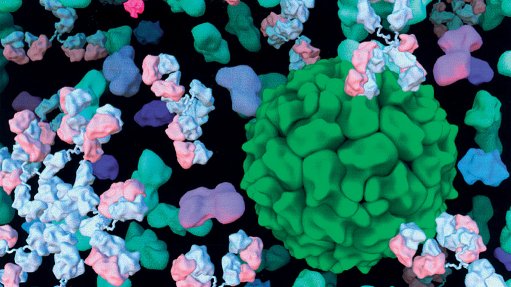
CRYSTALLOGRAPHY IN BIOLOGY: A coloured crystallography image of antibodies binding to a virus
Photo by: International Union of Crystallography
This year is the International Year of Crystallography (IYCr2014). It marks the centenary of the award of the Nobel Prize for Physics to Max vonLaue (1879-1960) of Germany for his discovery (published in 1912) that crystals diffract (that is, bend) X-rays. This discovery meant that the atomic and molecular structures of crystalline materials could be studied by using X-rays, and thus, as scientists rapidly made use of the breakthrough, created a new branch of science – radiocrystallography (now generally known simply as crystallography).
“These remarkable discoveries paved the way for a revolution in structural science,” highlighted the International Union of Crystallography (IUCr) President, Indian Institute of Science Professor Gautam Desiraju at the launch of the IYCr 2014. “Today, a hundred years later there is literally no branch of physics, chemistry, biology, medicine, mineralogy and structural and materials science that are untouched by crystallography.”
Crystallography has contributed to a greater or lesser extent to the researches – in biology, chemistry, medicine and physics – that led to the award of more than 25 Nobel Prizes over the past 100 years. “The benefits to mankind have been enormous and range from the discovery of medicines and drugs to materials that make the quality of life better for all,” he affirmed.
The IUCr is the lead sponsor of the IYCr 2014. It is partnered by the United Nations Educational, Scientific and Cultural Organisation (Unesco). The proposal that 2014 be made the International Year of Crystallography was made by Morocco in the United Nations General Assembly in July 2012.
“Crystallography has shaped the history of the 20th century,” stated Unesco Director-General Irina Bokova. “It has made a vital contribution to our understanding of life itself. ... In the past 50 years, the structures of more than 90 000 biological molecules have been revealed by crystallographers, with great ramifications for health care. Today, crystallography underpins all the sciences. It forms the backbone of a wide range of industries, including pharmaceuticals, agri-foodstuffs, aeronautics, computing, mining and space sciences. It is essential for the development of almost all new materials.”
Women have played a prominent role in crystallography. The work of RosalindFranklin (who tragically died of ovarian cancer in 1958, only three months short of her 38th birthday) contributed significantly to the understanding of the structure of DNA. Dorothy Hodgkin (1910-1994) won the Nobel Prize in Chemistry in 1964 for her use of the science to determine the structures of important biochemical substances. Ada Yonath (1939-) won the same prize in 2009 for her research into the structure and function of the ribosome.
The goals of IYCr2014 include increasing public awareness of the importance and universality of crystallography, to encourage international (especially North-South) cooperation, and to attract young people by means of exhibitions and demonstrations. It will have a strong educational element. There will be training schools in Africa, Asia and South America and travelling exhibitions in Africa, Asia, Latin America and the Middle East. The Crystallography in Africa programme will be reinforced and similar programmes created for Asia and latin America.
The IYCR2014 will also involve large synchrotron and neutron radiation facilities around the globe. One of these will be Unesco’s International Centre for Synchrotron-light for Experimental Science and Applications in the Middle East, which is based in Jordan and has nine member countries, including both Israel and Iran.
South Africa will host an international conference in Bloemfontein, while the University of the Witwatersrand host an exhibition showing the importance and usefulness of radiocrystallography across the sciences and technology, and displaying equipment.
Highlights
Crystallography has contributed to researches which have won more than 25 Nobel Prizes
Crystallography underpins all sciences and many technologies today